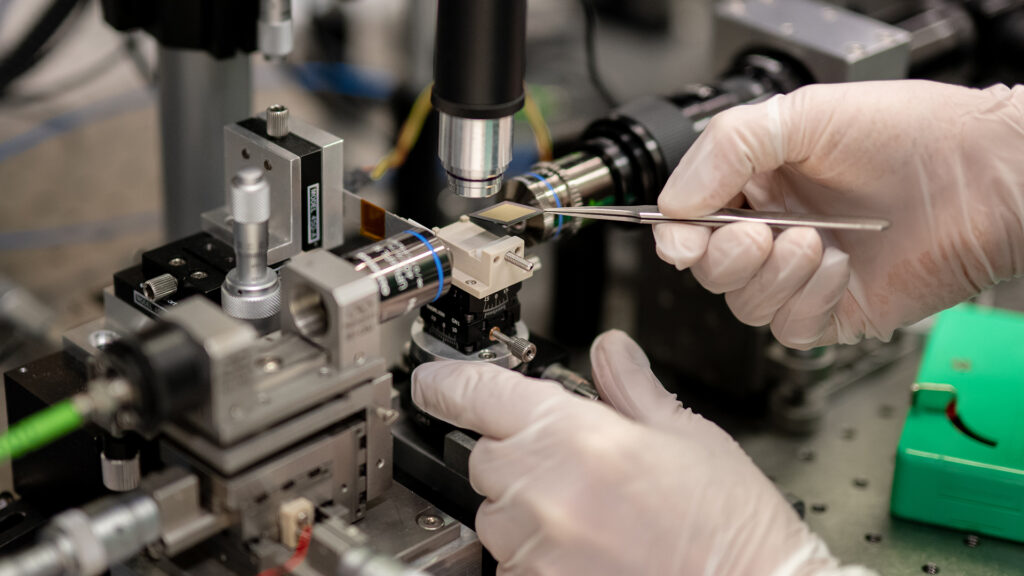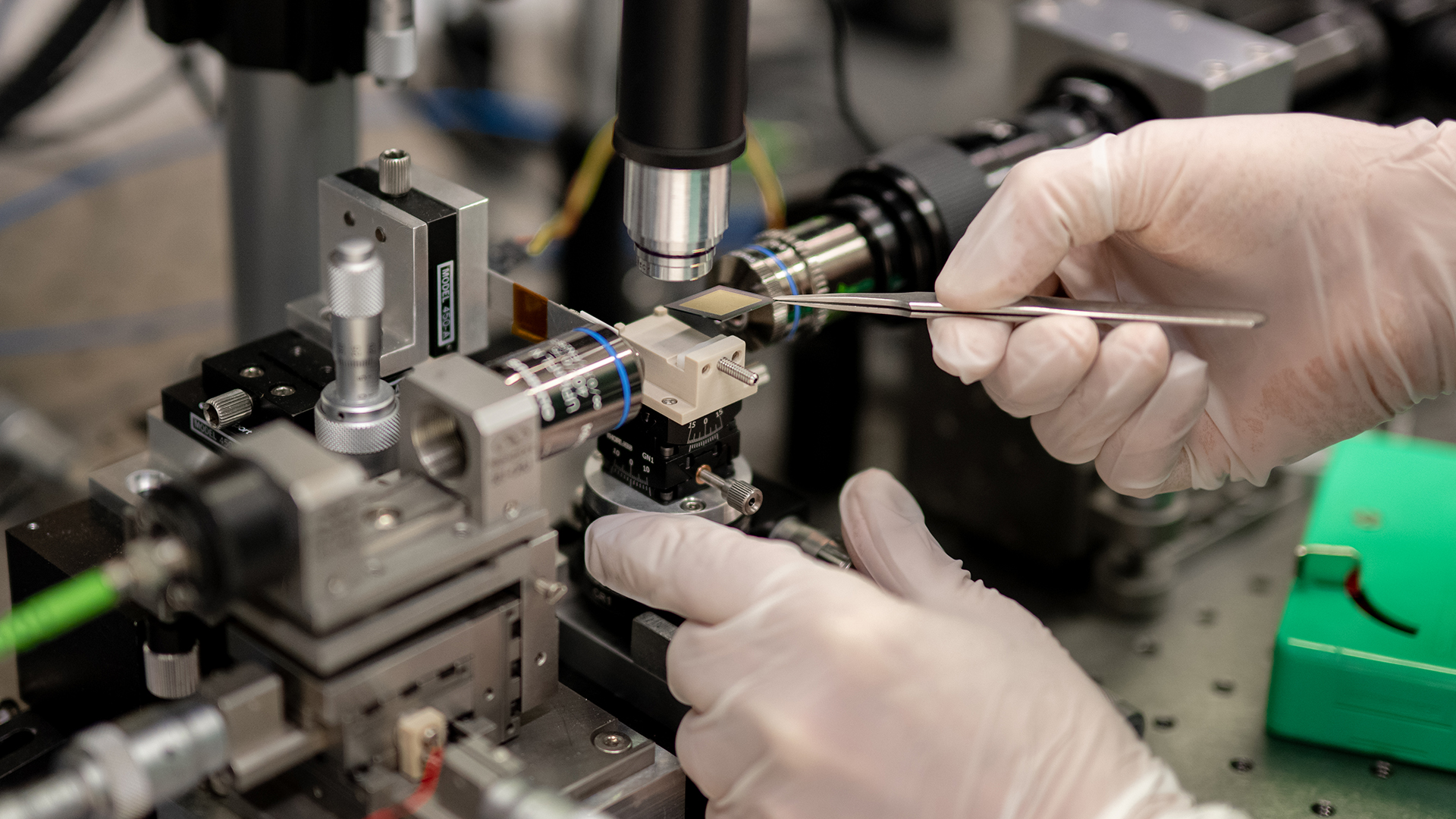
Navigation, medical imaging, and other areas could benefit from powerful new sensors that are based on detecting changes induced upon individual atoms.
As a technology, sensors are ubiquitous in modern life. From devices that measure a car’s speed and direction to accelerometers that flip phone screen orientations, we heavily rely on electronic sensors to detect and respond to physical inputs from the environment for safety as well as convenience.
For as good as sensors already are, vast untapped potential exists in a new kind of sensing technology that leverages the laws of quantum mechanics. Quantum sensors could be thousands of times more sensitive than those in use currently.
Quantum sensing technology accordingly stands poised to enhance everyday experiences and usher in new capabilities in navigation, geo-location, medical imaging, and other applications. SRI is helping to bring about this quantum-based future of sensing.
“SRI specializes in quantum sensing right now,” said Jesse Wodin, Director of the Applied Physics Lab at SRI. “We and our collaborators in government and industry recognize the tremendous potential offered by quantum sensing and we’re excited to continue moving the field forward.”
Sensors that measure behavioral variance
Conventional, classical sensing generally works on the scale of large collections of atoms in a sensor (like diodes and resistors, which are made from many atoms) interacting with signals such as radio waves and acceleration.
Quantum sensing, however, operates on the scale of individual atoms. The laws of quantum mechanics – which have been studied since the early 1900s – describe how subatomic particles such as photons (which comprise light) and electrons (the flow of which is electricity) interact with atoms.
With these interactions knowable to such a fine degree, SRI researchers are developing sensors that measure any behavioral variance introduced to an atomic system by forces of gravity, acceleration, or motion, as well as light and electric fields and magnetic fields.
“Once you shrink down to the atomic scale, you have to use all the laws of quantum mechanics to understand what’s going on,” said Wodin. “And those laws tell us just what to expect as change is introduced to an atom.”
In physical form, quantum sensors often appear as tiny glass cells or metallic chips containing single atoms or clouds of atoms, manipulated by lasers. To prepare the atoms in a stable state for subsequent variation measurements for sensing purposes, the atoms are first kept in a vacuum to avoid disruptions from random matter. Lasers further stabilize the atoms, trapping and sometimes cooling them while also serving as the means of “reading out” any changes in the atoms induced by exposure to electromagnetic fields or acceleration, for instance.
Quantum sensors that fit in a suitcase
Building off these concepts and architectures, Wodin and colleagues at SRI are working initially on several projects, with the goal of further bringing lab-proven technologies into real-life operational environments.
“We’re building hypersensitive magnetic field sensors, radiofrequency sensors, and a quantum gyroscope,” said Wodin. “In each case, the physics of detection is governed by quantum mechanics, which allows for incredible sensitivity and in theory can be orders of magnitude more sensitive than anything you can build conventionally.”
A recent advancement in this field is the Atomic Magnetometer for Biological Imaging in Earth’s Native Terrain (AMBIIENT). The technology, created with Twinleaf LLC and Princeton University, can perform live magnetocardiography, or the measurement of heart signals. Demonstrated live at Defense Advanced Research Projects Agency (DARPA) FORWARD, faint magnetic signals outside of an expensive shielded room were observed.
Advanced quantum sensors give us the ability to detect biological magnetic fields, which can make a difference when trying to detect a person trapped in building rubble, to offer an example. Such bio-magnetic fields are very difficult to isolate from the background noise of Earth’s natural, planetary magnetic field, seeing as the former are about a billion times weaker in strength than the latter.
To this end, SRI is working on developing quantum sensors on par with or better than the highest-performing magnetic field sensors of today, which must be shielded from Earth’s magnetic field. That need for shielding means such top-level sensors can only function in expensive, special-purpose labs and cannot be readily deployed to disaster sites.
“The idea is to build a quantum sensor the size of a phone that can go anywhere,” said Wodin. “This kind of device could have additional applications and be used as a mobile brain scanning system, for example.”
Quantum antennas and gyroscopes for added precision
SRI’s quantum antenna project centers on exquisite sensitivity to radio waves across a gigantic frequency range, from megahertz to terahertz, all in one single device. Nowadays, capturing this kind of range from satellites requires a bulky, expensive array of antennas, limiting how many platforms can be built, launched, and operated.
Outside of military applications, Wodin said, quantum antennas would prove useful aboard Earth observation satellites for forecasting weather and understanding longer-term climate change. At a fraction of today’s cost, these antennas could conduct signal mapping of atmospheric gases across many bands, improving data collection and analysis.
Still other quantum work at SRI involves powerful new quantum gyroscopes, which would enable vehicles to navigate accurately for long periods independently of Global Positioning System (GPS) signals. The atoms in such sensors would be prepared to be highly sensitive to acceleration, and reading out the atoms’ quantum states would inform navigational systems of precise position compared to a known starting point.
“You would want these gyroscopes on everything that has to navigate, whether its aircraft, helicopters, or drones, down to cars and other road vehicles, and on into the water on submarines,” said Wodin.
The breakthrough sensor technologies SRI is developing for the military and other strategic partners should find their way into everyday civilian use—much in the same way that the Internet and GPS began in the military sector before becoming household names and products.
“As quantum sensors become fielded and productized, they’ll get commercialized and integrated all over the place, eventually replacing a lot of classical sensors,” said Wodin. “We eagerly anticipate taking sensors to this whole new quantum level.”



